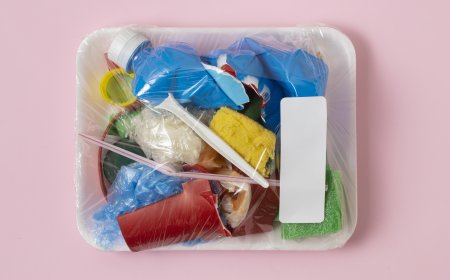Say Goodbye to Plastic Waste with Biodegradable Garbage Bags
Get the facts on how biodegradable garbage bags compare to regular plastic in everyday use.
In a world drowning in plastic, it's time to rethink our daily waste habitsstarting with garbage bags. The convenience of plastic trash bags has long come at a cost: overflowing landfills, clogged waterways, and toxic emissions. But today, biodegradable garbage bags offer a promising and planet-friendly solution. These eco-smart alternatives are not only functional but also key to reducing plastic waste at the source.
In this blog, we'll explore how biodegradable garbage bags work, their environmental advantages, and why making the switch is more than just a sustainable gestureits a step toward real change.
What Are Biodegradable Garbage Bags?
Biodegradable garbage bags are made from natural, plant-based materials such as cornstarch, cassava, or PLA (polylactic acid). Unlike conventional plastic bags, which can take hundreds of years to decompose, these eco-friendly options break down naturally in the presence of oxygen, moisture, and microorganisms.
Their primary appeal lies in the fact that they leave behind no toxic residue, unlike petroleum-based plastic bags, which release microplastics and harmful chemicals during degradation. This makes biodegradable garbage bags suitable for composting, especially when used to dispose of organic kitchen waste or green garden scraps.
Why Plastic Waste Is a Global Problem
To understand the importance of switching to biodegradable garbage bags, we need to consider the scale of plastic waste. The world produces over 300 million tons of plastic annually, and a significant portion of that ends up as single-use itemslike garbage bags. These bags are typically used once and discarded, often without proper disposal methods in place.
Conventional plastic bags:
-
Take 500 to 1,000 years to decompose
-
Leach harmful chemicals into soil and water
-
Block drains, harm wildlife, and contaminate food chains
Worse still, incinerating plastic releases dioxins and other toxins into the air, contributing to both air pollution and climate change.
Benefits of Biodegradable Garbage Bags
Biodegradable garbage bags are not just about conveniencethey come with a variety of environmental and functional benefits:
1. Faster Decomposition
Unlike traditional plastic, biodegradable bags begin breaking down within weeks to months, depending on environmental conditions. This rapid decomposition significantly reduces landfill waste.
2. Less Environmental Pollution
These bags degrade into natural elements like carbon dioxide and water, leaving behind no microplastics or harmful residue, making them safe for soil and marine ecosystems.
3. Compost-Friendly
Many biodegradable garbage bags are certified compostable, meaning they can be safely added to industrial or home composting systems along with food waste.
4. Supports Green Living
By choosing biodegradable garbage bags, consumers and businesses actively reduce their environmental impact and contribute to sustainable waste management.
5. Aligns with Regulations
Countries like India, France, and parts of the U.S. are imposing strict bans or restrictions on plastic bags. Switching to biodegradable garbage bags helps you stay compliant with evolving laws.
Where Can You Use Biodegradable Garbage Bags?
Biodegradable garbage bags are versatile and can be used in a variety of settings:
-
Homes: For kitchen waste, bathroom bins, and garden cleanup
-
Offices: In workstations, cafeterias, and meeting rooms
-
Hotels & Restaurants: For organic and dry waste segregation
-
Hospitals: In non-hazardous areas to reduce plastic footprint
-
Public Events: Eco-conscious waste management for large gatherings
They are available in multiple sizes and strengthsranging from small liners for desk bins to large bags for bulk disposal.
Biodegradable vs. Compostable Bags: Whats the Difference?
While often used interchangeably, biodegradable and compostable bags have distinct properties:
-
Biodegradable bags break down naturally but may still leave behind some residue depending on the material.
-
Compostable bags completely break down into non-toxic elements under specific composting conditions, typically within 90180 days.
For best results, look for bags certified by standards such as:
-
EN 13432 (Europe)
-
ASTM D6400 (USA)
-
IS/ISO 17088 (India)
These certifications ensure the bag truly performs as claimed.
Challenges to Be Aware Of
Biodegradable garbage bags are not perfect. They need proper conditions to decompose efficientlyheat, moisture, and microbes. If sent to a landfill and sealed off from air and moisture, they may behave similarly to plastic. Therefore, pairing them with better waste segregation and composting practices is crucial.
Additionally, some bags labeled as biodegradable may be oxo-degradableplastic bags with additives that break them into microplastics. These are not truly biodegradable and should be avoided.
How to Choose the Right Biodegradable Garbage Bag
When selecting biodegradable garbage bags, consider:
-
Material origin: Cornstarch, PLA, etc.
-
Tear resistance and load capacity
-
Certifications for compostability
-
Shelf life (since some degrade in storage)
-
Size and type (drawstring, flat bottom, etc.)
Choose a reliable supplier that is transparent about materials and complies with local environmental regulations.
Conclusion
Biodegradable garbage bags are a powerful step toward reducing our dependency on plastic and managing waste responsibly. They're not just a trendtheyre a practical, scalable solution to a growing problem. As we work toward a cleaner, greener planet, these bags play a crucial role in transforming how we deal with everyday waste.
Say goodbye to plastic waste and hello to a cleaner consciencewith biodegradable garbage bags leading the way.


































